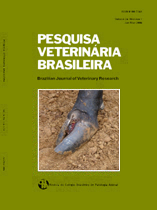 |
|
|
|
Year 2009 - Volume 29, Number 11
|

|
Health management practices and disease prevalence in dairy sheep systems in Argentina, 29(11):931-937
|
ABSTRACT.- Suárez V.H. & Busetti M.R. 2009. Health management practices and disease prevalence in dairy sheep systems in Argentina. Pesquisa Veterinária Brasileira 29(11):931-937. Estación Experimental Agropecuaria de Anguil, INTA, CC 11, 6326 Anguil, La Pampa, Argentina. E-mail: vsuarez@anguil.inta.gov.ar
A cross-sectional survey of 19 dairy sheep farms in Argentina was carried out with the purpose to know farm management, health practices, and occurrence and mortality of diseases. The survey comprised 40% of all sheep milking farms in Argentina. A questionnaire was conducted by way of personal interviews with sheep owners during farm visits. The proportions of farms reporting routine vaccination for clostridial diseases, contagious ecthyma, pneumonia and mineral and vitamin parenteral administration were 63%, 47.3%, 16.6% and 42.1% respectively. Regular treatment against lice was used in 37.5% of the farms, and 89.5% o the farmers treated against gastrointestinal nematodes (GIN). The mean number of GIN drenches per farm was 2.26±1.78 annually. In 68.4% of the milking flocks the California Mastitis Test was regularly done and 55.6% of the farmer managers had sampled their flocks once a year for Brucella ovis antibodies. During the pre-mating period respectively 68.4% and 50% of farmers clinically examined their rams and ewe for general health and teeth condition. The udders of ewes were frequently inspected at the start of each milking period. The most important parasite problems noticed were GIN (reported by 57.9% of farmers), lice (57.9%) and scabies (10.5%) and the most frequent infectious diseases were ecthyma (73.7%), pneumonia and other respiratory problems (57.9%), clinical mastitis (55.6%), clostridial diseases (36.9%) and foot lameness (35.2%). Photosensitivity (47.4%) and ruminal acidosis (42.1%) were reported as other frequent toxic or metabolic disorders. Owners mentioned that the mean lifespan or milk productive time per ewe was 4.5±1.4 years. Perinatal lamb mortality was 8.5% and the total flock mortality rates, above the first 24 h of life was 6.9%. The high rates of lamb mortality during the pre-weaning (10.3%) and post-weaning (5.9%) periods indicate that this problem, as well as the most prevalent diseases, should be the subject of further studies. |
| |
|
|
| |
|
 |